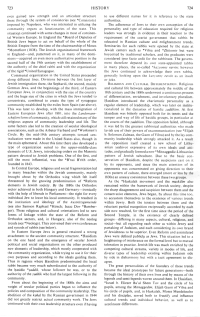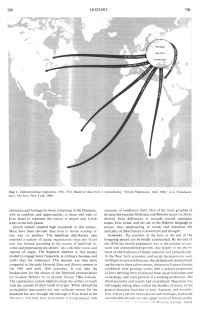[East
European communities: Hasidism and new political and
social organizations - 1844: Russian prohibition of
Jewish communities has no effect - czarist rabbinical
regulations without success]
<In Eastern Europe Jews in general retained a strong
attachment to the ancient community structure. *Hasidism
on the one hand and the emergence of secular Jewish
political and social organizations on the other produced
new elements of leadership, which mostly cooperated with
the community organization, while trying to use it for
their own purposes and according to the ideals guiding
them. Thus in regions where Hasidism predominated the
local rabbi became very much subordinated to the authority
of the hasidic *zaddik
[[righteous]], whose follower he was, or to the authority
of the zaddik
who had the largest following in the community.
From about the beginning of the 1880s the aims and weight
of secular political parties began to influence the
policies and composition of the community leadership. The
abolition of the kahal
[[community]] by the Russian government in 1844 did not
greatly restrict actual community work. The Jews continued
with their own leadership structure even if having (col.
723)
to use different names for it in reference to the state
authorities.
The adherence of Jews to their own conception of the
personality and type of education required for religious
leaders was strongly in evidence in their reaction to the
requirement of the czarist government that rabbis be
educated in Russian culture and enlightenment trends.
Seminaries for such rabbis were opened by the state at
Jewish centers such as *Vilna and *Zhitomir but were
boycotted by traditional scholars, and the graduates were
considered ipso facto unfit for the rabbinate. The
government therefore deputed its own state-appointed
rabbis in many places, the so-called *kazyonny ravvin;
however the Jews continued to acknowledge their own
rabbis, generally looking upon the kazyonny ravvin as an
insult or joke.>
RELIGIOUS AND CULTURAL DIFFERENTIATION.
[Hasidism (religious) and
zaddikim (the righteous) - creation of Lithuanian
yeshivot (Jewish religion schools) - coexistence]
Religious and cultural life between approximately the
middle of the 18th century and the 1880s underwent a
continuous process of differentiation, enrichment, and
involuntary pluralism. Hasidism introduced the charismatic
personality as a regular element of leadership, which was
later on institutionalized in the dynasties of hasidic zaddikim. At first
Hasidism was bitterly opposed both for its tenets and the
temper and way of life of hasidic groups, in particular at
the courts of the zaddikim
[[courts of the justs]]. The opposition failed, although
it was led by the greatest rabbinical authorities who made
lavish use of their powers of excommunication (see *Elija
b. Solomon Zalman, the Gaon of Vilna) and by the lay
community leadership which strongly attacked it.
As a result the opposition itself created a new school of
Lithuanian yeshivot [[Jewish religion schools]] expressive
of its own ideals and attitudes, and gradually formed a
new *Mitnaggedic-Lithuanian pattern of Jewish subculture
[[Mitnagdim]]. Due to the basic conservatism of Hasidism,
despite the suspicions cast on it by its opponents, and
since the main attention of its opponents was concentrated
on giving direction to their own pattern of culture, there
emerged (more or less by the 1830s) an uneasy coexistence
between these two groups.
[Enlightenment movements:
Haskalah and maskilim]
As the *Haskalah movement [[Jewish Enlightenment
movement]] and the maskilim
[[Enlightenment philosophers]] also remained within the
framework of Jewish society, despite the sharp
disagreement and suspicion between them and the
conservative elements, Jews began, by about this time too,
to accustom themselves to the existence of various trends
within Jewry. Both the tension between them and the
reluctant partial recognition reciprocally accorded by
each side now resulted, for the first time since the
period of the Second Temple, in the existence of clearly
defined groups - differing in many aspects, cultural,
religious, and social - but all regarding each other as
within Jewry and partaking of Judaism, and each
considering its own brand of Jewishness to be superior.
Even Reform and assimilated Jews were defined publicly as
Jews. This situation led to a heightening of intolerance
on the formal level but to mutual toleration in practice.
Jewish life was much enriched by the competing cultural
streams, variety in modes of life, and diverse types of
leadership existing within Judaism side by side in
disharmony but with a tacit agreement to disagree.
The great personalities of the founders of these trends
became the ideal prototypes for future generations - both
through the history of their own lives and by means of the
legends and semi-legends woven around them. In Hasidism,
*Israel b. Eliezer Ba'al Shem Tov and the circle of his
pupils, among the Mitnaggedim,
Elijah Gaon of Vilna and his circle of pupils, and, in
Haskalah, Moses Mendelssohn and his disciples, served both
to fructify and influence cultural trends and individual
behavior, as well as to accentuate differences. (col. 724)
[Hasidism (religious)
with dances, songs, tales, and wonder accounts has
effects with movements, schools, Jewish youth, and
literature]
Elements in Hasidism such as the hasidic *dance and song,
the camaraderie of hasidic groups and courts, hasidic
tales and accounts of wonders, not only colored the
culture of the majority of East European Jewry but later,
in the 20th century, influenced semi-secular and secular
teachings and movements, like those of Martin *Buber and
*Ha-Shomer ha-Za'ir in its early stages, as well as the
patterns of behavior of many other Jewish youth groups in
the late 19th and the first half of the 20th century, and
much of secular Hebrew and Yiddish literature.
[Mitnaggedic (other
religious) Jewish culture in Lithuania]
The Mitnaggedic Jewish culture both created
representatives of a scholarly lay elite in the Lithuanian
towns and townships, and did much to give new stature and
dimensions to the *talmid
hakham (talmid
ḥakham) [[disciple of the wise, scholar]]. The
influence of Mitnaggedim
ideals and attitudes is reflected in the teachings of men
like Simon *Dubnow and in much of the secular and
non-ecstatic trends of Jewish life in Erez Israel, the
United States, and in *South Africa.
Haskalah led in many cases to extreme assimilation, but on
the other hand it continued, in particular in Eastern
Europe, its original cultivation of Hebrew, and its
creation of a secular Jewish literature, in philosophy,
historiography, and above all, in belles lettres
[[literature]].> (col. 725)
[[ ... paragraph
about Haskalah in Central and Western Europe ... ]]
[Haskalah (Enlightenment)
movement in Eastern Europe: Quarrels about languages,
school systems, dresses and customs - Haskalah
enlightenment is the base for Zionism development]
In Eastern Europe Haskalah often provoked the opposition
of the Jewish masses through the collaboration of its
enthusiasts with oppressive governments in attempts to
impose on them secular education and changes of language,
*dress, and custom. Yet it was mainly on the foundations
laid by Haskalah thinking, methods, and achievements that
secular Hebrew culture and literature could develop within
the framework of Zionism in the 20th century.> (col.
725)
<One of the main grounds of division between the
Orthodox and Reform sectors in Jewry derived from
differences in attitude towards messianic hopes, Erez
Israel, and the use of the Hebrew language in prayer, thus
emphasizing in minds and emotions the centrality of these
factors to Jewish life and thought.> (col. 730)






